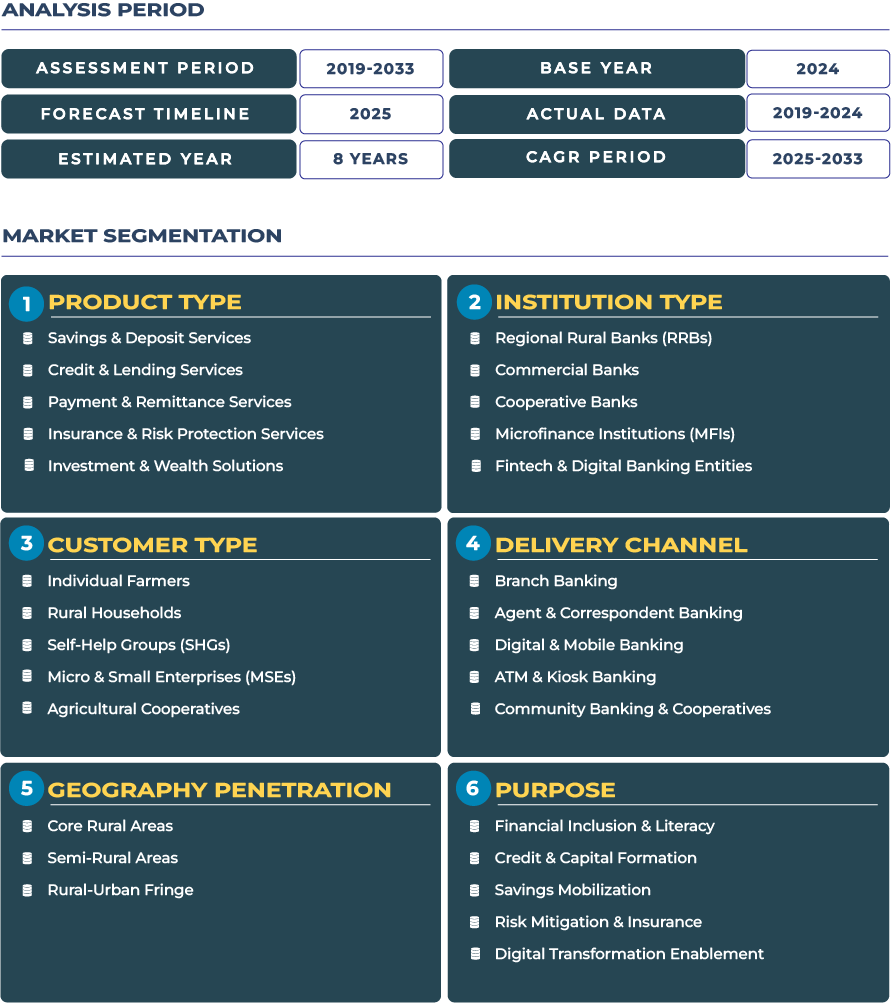Thailand Rural Banking Market Outlook: Tourism-Linked Prosperity Fuels Financial Inclusion
Thailand rural banking market is witnessing a profound transformation, fueled by the country’s unique integration of tourism and rural livelihood finance. As one of Southeast Asia’s most tourism-dependent economies, Thailand’s villages have long been the backbone of both its agricultural output and cultural tourism appeal. This interlinkage is now reshaping rural banking practices, from microcredit for homestays to agricultural-linked savings instruments. The nation’s banks, under the guidance of the Bank of Thailand, are strengthening the financial inclusion ecosystem, enabling rural communities to access sustainable and affordable banking services.
Note:* The market size refers to the total fees/revenue generated by banks through various services.
In 2025, Thailand rural banking industry is valued at USD 12.9 billion and is projected to reach USD 20.1 billion by 2033, expanding at a CAGR of 5.7% (2025–2033). This growth trajectory is supported by expanding digital penetration, government-led community fund initiatives, and a gradual rebound of rural tourism post-pandemic. As a result, the rural financial landscape is evolving from a subsistence-driven model to a diversified, digitally-enabled credit ecosystem that empowers both farmers and microentrepreneurs.
Manufacturing and Agri-Cluster Synergy Powering Vietnam’s Rural Banking Expansion
The Vietnam rural banking landscape is deeply intertwined with the country’s manufacturing and agricultural cluster development strategy. In provinces such as Bac Ninh, Thai Binh, and Dong Nai, rural manufacturing zones specializing in textiles, ceramics, and food processing are emerging as engines of local employment. To support these clusters, banks and cooperatives are introducing credit and lending services tailored to working capital cycles and trade-finance needs. Parallelly, payment and remittance services have become more digitalized, facilitating smoother transactions for migrant workers sending funds to rural families.
Government initiatives under the Ministry of Planning and Investment and Ministry of Agriculture and Rural Development are promoting inclusive rural financing models that blend micro-lending with enterprise development. The combination of agriculture-linked value chains and rural industrial networks has positioned Vietnam as a unique case of dual-sector rural development, where both farmers and small manufacturers benefit from integrated financial services. As the economy continues to urbanize, Vietnam rural banking sector will remain critical in sustaining equitable growth and financial inclusion.
Drivers & Restraints: Industrial Clusters, Mobile Payment Uptake, and Land Complexity Shape Growth Dynamics
Rural Manufacturing and Mobile Finance Accelerating Financial Inclusion
One of the strongest growth drivers for the rural banking industry in Vietnam is the rise of manufacturing clusters in peri-urban and rural districts. These clusters, particularly in the textile, seafood processing, and handicraft sectors, have significantly increased demand for credit and lending services and small-business banking products. The adoption of mobile payment systems, such as those integrated under the National Payment Corporation of Vietnam (NAPAS), has further expanded transaction efficiency across rural areas. Small traders and contract farmers now use QR-based and digital wallet payments for settlements, promoting traceability and reducing dependence on cash-based lending.
Land-Use Rights and Fragmented Farm Ownership Restrict Credit Access
However, the rural banking sector also faces structural limitations. Vietnam’s land-use rights complexity, wherein households lease land rather than own it outright, creates collateralization challenges for formal lending institutions. Many smallholder farmers operate on fragmented plots, limiting their ability to secure larger credit lines. Additionally, the rural financial literacy gap continues to affect adoption of advanced products like insurance and risk protection services. Without clearer land titling frameworks and improved documentation practices, banks must rely on innovative models such as cash-flow-based lending and peer credit scoring to expand outreach.
Trends & Opportunities: From Contract Farming to Cluster-Based Export Financing
Contract-Farming with Agro-Processors Redefines Rural Credit Flow
Contract farming has emerged as a transformative trend within Vietnam rural banking sector. Large agro-processors in provinces like Lam Dong and An Giang now collaborate with banks to facilitate pre-harvest financing for coffee, pepper, and rice farmers. By linking payment assurance with harvest contracts, financial institutions reduce risk exposure while empowering farmers with predictable income flows. Simultaneously, investment and wealth solutions are gaining traction among rural cooperatives, which are pooling community savings into rotational lending funds.
Opportunities in Cold-Chain and Invoice Financing for Rural Exporters
The next wave of opportunities in Vietnam’s rural financial ecosystem lies in cluster-based cold-chain finance and invoice discounting for small textile exporters. These mechanisms address liquidity constraints faced by rural SMEs operating in export-dependent industries. For instance, micro-cold chain financing is helping high-altitude coffee and pepper farmers in Dak Lak and Gia Lai reduce post-harvest losses and access premium international markets. Likewise, invoice discounting platforms are being adopted by small textile exporters in Nam Dinh, allowing faster cash flow turnaround without long bank processing delays. Together, these trends underscore Vietnam’s commitment to building a digitally integrated, export-oriented rural economy.
Competitive Landscape: Vietnamese Banks and Fintechs Redefine Rural Financing Strategies
Key players such as the Vietnam Bank for Agriculture and Rural Development (Agribank) and the Joint Stock Commercial Bank for Foreign Trade of Vietnam (Vietcombank) continue to dominate rural credit disbursement. Their digital outreach programs and branchless banking models are vital for extending services to remote communities. As competition intensifies, banks are prioritizing blended-finance solutions that merge tourism, agriculture, and manufacturing-linked credit. This transition from basic microfinance to structured, tech-enabled credit instruments is positioning Vietnam rural banking sector as a cornerstone of its inclusive growth journey.







